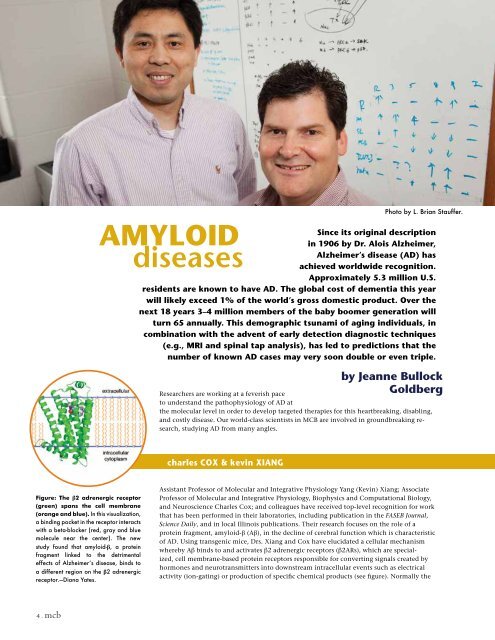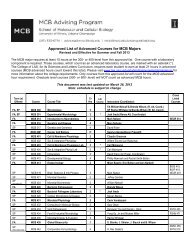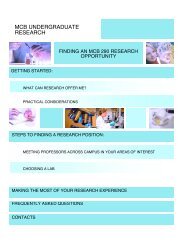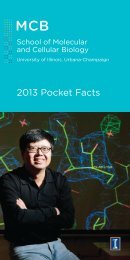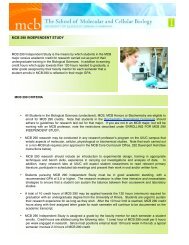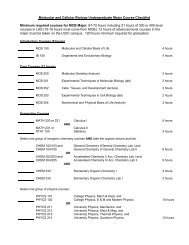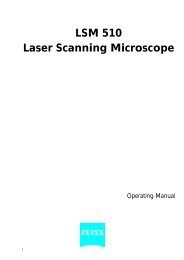collaboration in the life sciences - The School of Molecular and ...
collaboration in the life sciences - The School of Molecular and ...
collaboration in the life sciences - The School of Molecular and ...
Create successful ePaper yourself
Turn your PDF publications into a flip-book with our unique Google optimized e-Paper software.
AMYLOID<br />
diseases<br />
Photo by L. Brian Stauffer.<br />
S<strong>in</strong>ce its orig<strong>in</strong>al description<br />
<strong>in</strong> 1906 by Dr. Alois Alzheimer,<br />
Alzheimer’s disease (AD) has<br />
achieved worldwide recognition.<br />
Approximately 5.3 million U.S.<br />
residents are known to have AD. <strong>The</strong> global cost <strong>of</strong> dementia this year<br />
will likely exceed 1% <strong>of</strong> <strong>the</strong> world’s gross domestic product. Over <strong>the</strong><br />
next 18 years 3–4 million members <strong>of</strong> <strong>the</strong> baby boomer generation will<br />
turn 65 annually. This demographic tsunami <strong>of</strong> ag<strong>in</strong>g <strong>in</strong>dividuals, <strong>in</strong><br />
comb<strong>in</strong>ation with <strong>the</strong> advent <strong>of</strong> early detection diagnostic techniques<br />
(e.g., MRI <strong>and</strong> sp<strong>in</strong>al tap analysis), has led to predictions that <strong>the</strong><br />
number <strong>of</strong> known AD cases may very soon double or even triple.<br />
by Jeanne Bullock<br />
Goldberg<br />
Researchers are work<strong>in</strong>g at a feverish pace<br />
to underst<strong>and</strong> <strong>the</strong> pathophysiology <strong>of</strong> AD at<br />
<strong>the</strong> molecular level <strong>in</strong> order to develop targeted <strong>the</strong>rapies for this heartbreak<strong>in</strong>g, disabl<strong>in</strong>g,<br />
<strong>and</strong> costly disease. Our world-class scientists <strong>in</strong> MCB are <strong>in</strong>volved <strong>in</strong> groundbreak<strong>in</strong>g research,<br />
study<strong>in</strong>g AD from many angles.<br />
charles COX & kev<strong>in</strong> XIANG<br />
Figure: <strong>The</strong> β2 adrenergic receptor<br />
(green) spans <strong>the</strong> cell membrane<br />
(orange <strong>and</strong> blue). In this visualization,<br />
a b<strong>in</strong>d<strong>in</strong>g pocket <strong>in</strong> <strong>the</strong> receptor <strong>in</strong>teracts<br />
with a beta-blocker (red, gray <strong>and</strong> blue<br />
molecule near <strong>the</strong> center). <strong>The</strong> new<br />
study found that amyloid-β, a prote<strong>in</strong><br />
fragment l<strong>in</strong>ked to <strong>the</strong> detrimental<br />
effects <strong>of</strong> Alzheimer’s disease, b<strong>in</strong>ds to<br />
a different region on <strong>the</strong> β2 adrenergic<br />
receptor.—Diana Yates.<br />
Assistant Pr<strong>of</strong>essor <strong>of</strong> <strong>Molecular</strong> <strong>and</strong> Integrative Physiology Yang (Kev<strong>in</strong>) Xiang; Associate<br />
Pr<strong>of</strong>essor <strong>of</strong> <strong>Molecular</strong> <strong>and</strong> Integrative Physiology, Biophysics <strong>and</strong> Computational Biology,<br />
<strong>and</strong> Neuroscience Charles Cox; <strong>and</strong> colleagues have received top-level recognition for work<br />
that has been performed <strong>in</strong> <strong>the</strong>ir laboratories, <strong>in</strong>clud<strong>in</strong>g publication <strong>in</strong> <strong>the</strong> FASEB Journal,<br />
Science Daily, <strong>and</strong> <strong>in</strong> local Ill<strong>in</strong>ois publications. <strong>The</strong>ir research focuses on <strong>the</strong> role <strong>of</strong> a<br />
prote<strong>in</strong> fragment, amyloid-β (Aβ), <strong>in</strong> <strong>the</strong> decl<strong>in</strong>e <strong>of</strong> cerebral function which is characteristic<br />
<strong>of</strong> AD. Us<strong>in</strong>g transgenic mice, Drs. Xiang <strong>and</strong> Cox have elucidated a cellular mechanism<br />
whereby Aβ b<strong>in</strong>ds to <strong>and</strong> activates β2 adrenergic receptors (β2ARs), which are specialized,<br />
cell membrane-based prote<strong>in</strong> receptors responsible for convert<strong>in</strong>g signals created by<br />
hormones <strong>and</strong> neurotransmitters <strong>in</strong>to downstream <strong>in</strong>tracellular events such as electrical<br />
activity (ion-gat<strong>in</strong>g) or production <strong>of</strong> specific chemical products (see figure). Normally <strong>the</strong><br />
4 . mcb


